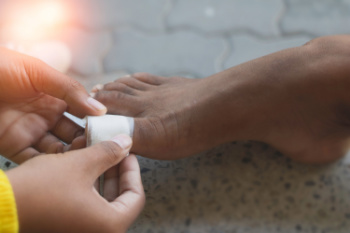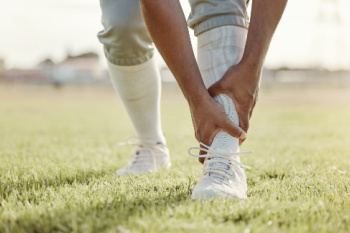Yakima
(509) 225-3668
Ellensburg
(509) 925-4633

Flat feet surgery aims to correct the arch of the foot and alleviate associated symptoms like pain and difficulty walking. There are various types of surgical procedures, depending on the severity and underlying cause of the flat feet condition. Lateral column lengthening involves cutting and repositioning bones in the outer foot to create an arch. This procedure stabilizes the midfoot and improves weight distribution. Flexor digitorum longus transfer redirects a tendon from the toe to support the arch, enhancing its structure and function. Both surgeries aim to restore the foot's natural alignment and reduce strain on surrounding muscles and joints. Recovery typically involves immobilization to regain strength and mobility. Surgical intervention is considered when conservative treatments like orthotics and exercises fail to provide sufficient relief, aiming to improve foot function and quality of life for individuals with flat feet. If you are experiencing chronic pain from having flat feet, it is strongly suggested that you consult a podiatrist who can determine if flat foot surgery is right for you.
Foot surgery is sometimes necessary to treat a foot ailment. To learn more, contact one of our podiatrists of Cascade Foot & Ankle. Our doctors will assist you with all of your foot and ankle needs.
When Is Surgery Necessary?
Foot and ankle surgery is generally reserved for cases in which less invasive, conservative procedures have failed to alleviate the problem. Some of the cases in which surgery may be necessary include:
What Types of Surgery Are There?
The type of surgery you receive will depend on the nature of the problem you have. Some of the possible surgeries include:
Benefits of Surgery
Although surgery is usually a last resort, it can provide more complete pain relief compared to non-surgical methods and may allow you to finally resume full activity.
Surgical techniques have also become increasingly sophisticated. Techniques like endoscopic surgery allow for smaller incisions and faster recovery times.
If you have any questions please feel free to contact our offices located in Yakima and Ellensburg, WA . We offer the newest diagnostic and treatment technologies for all your foot and ankle needs.
 Foot blisters are caused by friction, excessive moisture, or from wearing ill-fitting shoes. While it may be tempting to pop them, it is best to let blisters heal naturally to prevent infection. To care for blisters at home, start by cleaning the area with mild soap and water. Apply an antiseptic and cover the blister with a sterile bandage or blister pad to protect it from further irritation. Keeping the blister dry is important for faster healing. Wear moisture-wicking socks and properly fitting shoes to reduce friction. If the blister is painful, cushion it with moleskin or a soft bandage to alleviate pressure. Avoid activities that exacerbate the blister, and allow your feet to rest and recover. If blisters do not heal, recur frequently, or cause significant pain, it is suggested that you consult a podiatrist who can provide professional care and address underlying issues.
Foot blisters are caused by friction, excessive moisture, or from wearing ill-fitting shoes. While it may be tempting to pop them, it is best to let blisters heal naturally to prevent infection. To care for blisters at home, start by cleaning the area with mild soap and water. Apply an antiseptic and cover the blister with a sterile bandage or blister pad to protect it from further irritation. Keeping the blister dry is important for faster healing. Wear moisture-wicking socks and properly fitting shoes to reduce friction. If the blister is painful, cushion it with moleskin or a soft bandage to alleviate pressure. Avoid activities that exacerbate the blister, and allow your feet to rest and recover. If blisters do not heal, recur frequently, or cause significant pain, it is suggested that you consult a podiatrist who can provide professional care and address underlying issues.
Blisters may appear as a single bubble or in a cluster. They can cause a lot of pain and may be filled with pus, blood, or watery serum. If your feet are hurting, contact one of our podiatrists of Cascade Foot & Ankle. Our doctors can provide the care you need to keep you pain-free and on your feet.
Foot Blisters
Foot blisters are often the result of friction. This happens due to the constant rubbing from shoes, which can lead to pain.
What Are Foot Blisters?
A foot blister is a small fluid-filled pocket that forms on the upper-most layer of the skin. Blisters are filled with clear fluid and can lead to blood drainage or pus if the area becomes infected.
Symptoms
(Blister symptoms may vary depending on what is causing them)
Prevention & Treatment
In order to prevent blisters, you should be sure to wear comfortable shoes with socks that cushion your feet and absorb sweat. Breaking a blister open may increase your chances of developing an infection. However, if your blister breaks, you should wash the area with soap and water immediately and then apply a bandage to the affected area. If your blisters cause severe pain it is important that you call your podiatrist right away.
If you have any questions, please feel free to contact our offices located in Yakima and Ellensburg, WA . We offer the newest diagnostic and treatment technologies for all your foot care needs.

Tarsal tunnel syndrome occurs when the posterior tibial nerve is compressed within the tarsal tunnel, leading to a range of symptoms. Individuals with this condition often experience pain, tingling, or numbness in the foot or ankle, particularly along the inner side. Symptoms may worsen with prolonged standing or walking. Diagnosing tarsal tunnel syndrome involves a thorough physical examination, where a podiatrist may assess nerve function and look for signs of compression. Diagnostic tests such as nerve conduction studies or an MRI scan may be used to confirm the diagnosis. Conservative treatments such as rest and anti-inflammatory medications may offer relief. Wearing supportive footwear and using orthotics may help to alleviate pressure on the nerve. If you have pain in the inside of your foot, it is suggested that you consult a podiatrist who can accurately diagnose and treat tarsal tunnel syndrome.
Tarsal tunnel syndrome can be very uncomfortable to live with. If you are experiencing tarsal tunnel syndrome, contact one of our podiatrists of Cascade Foot & Ankle. Our doctors can provide the care you need to keep you pain-free and on your feet.
Tarsal Tunnel Syndrome
Tarsal tunnel syndrome, which can also be called tibial nerve dysfunction, is an uncommon condition of misfiring peripheral nerves in the foot. The tibial nerve is the peripheral nerve in the leg responsible for sensation and movement of the foot and calf muscles. In tarsal tunnel syndrome, the tibial nerve is damaged, causing problems with movement and feeling in the foot of the affected leg.
Common Cause of Tarsal Tunnel Syndrome
The Effects of Tarsal Tunnel Syndrome
A physical exam of the leg can help identify the presence of tarsal tunnel syndrome. Medical tests, such as a nerve biopsy, are also used to diagnose the condition. Patients may receive physical therapy and prescriptive medication. In extreme cases, some may require surgery.
If you have any questions please feel free to contact our offices located in Yakima and Ellensburg, WA . We offer the newest diagnostic and treatment technologies for all your foot and ankle needs.

There are several types of foot and ankle injuries that can occur when playing sports. The most common sports injury is an ankle sprain. It is important for ankle sprains to be diagnosed and treated professionally, as an improperly healed ankle can lead to additional sprains, chronic ankle instability, and arthritis. Another type of injury athletes face involves the Achilles tendon, which can become inflamed, injured, torn, or even ruptured from repetitive activity or trauma. An inflammation of the plantar fascia that runs along the sole of the foot is termed plantar fasciitis. It can be caused by overuse, wearing shoes that are worn out, or footwear that is not appropriate for a particular sport or activity. Running and court sports can lead to a compression of the nerve between the third and fourth toes, resulting in a condition known as Morton’s neuroma. This causes the tissue surrounding the nerve to thicken, and if left untreated may result in nerve damage. If you have suffered a foot, toe, or ankle injury while playing sports, it’s suggested that you contact a podiatrist.
Sports related foot and ankle injuries require proper treatment before players can go back to their regular routines. For more information, contact one of our podiatrists of Cascade Foot & Ankle. Our doctors can provide the care you need to keep you pain-free and on your feet.
Sports Related Foot and Ankle Injuries
Foot and ankle injuries are a common occurrence when it comes to athletes of any sport. While many athletes dismiss the initial aches and pains, the truth is that ignoring potential foot and ankle injuries can lead to serious problems. As athletes continue to place pressure and strain the area further, a mild injury can turn into something as serious as a rupture and may lead to a permanent disability. There are many factors that contribute to sports related foot and ankle injuries, which include failure to warm up properly, not providing support or wearing bad footwear. Common injuries and conditions athletes face, including:
Sports related injuries are commonly treated using the RICE method. This includes rest, applying ice to the injured area, compression and elevating the ankle. More serious sprains and injuries may require surgery, which could include arthroscopic and reconstructive surgery. Rehabilitation and therapy may also be required in order to get any recovering athlete to become fully functional again. Any unusual aches and pains an athlete sustains must be evaluated by a licensed, reputable medical professional.
If you have any questions please feel free to contact our offices located in Yakima and Ellensburg, WA . We offer the newest diagnostic and treatment technologies for all your foot and ankle needs.